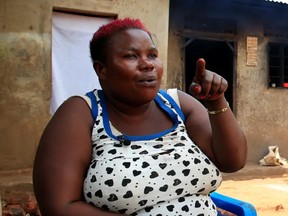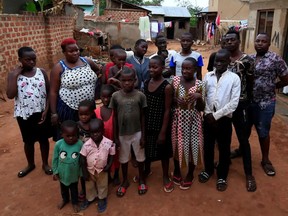Biological Anomaly : Raising a LARGE Family
"Her case is a genetic predisposition to hyperovulate -- releasing multiple eggs in one cycle -- which significantly increases the chances of having multiple births."Dr.Charles Kiggundu, gynecologist Mulago Hospital, Kampala, Uganda"I have grown up in tears, my man has passed me through a lot of suffering.""All my time has been spent looking after my children and working to earn some money.""I started taking on adult responsibilities at an early stage. I have not had joy, I think, since I was born.""I can't say they [her children] are nagging because they are my children. I can't say I will abandon them because they are my children, and I love them."Mariam Nahatanzi"Mum is overwhelmed; the work is crushing her.""We help where we can, like in cooking and washing, but she still carries the whole burden for the family.""I feel for her."Ivan Kibuka, mid-20s, eldest child
 |
According to the Mayo Clinic, ovarian hyperstimulation syndrome can be "life threatening". It can cause "blood clots, kidney failure, twisting of the ovary or breathing problems".
Treatment, available in wealthy first-world nations, is not available
in Uganda. Nabatanzi had an unfortunate upbringing from the very
beginning of her life, with her mother who had five boys before her,
abandoning her family when the last, the girl that would become a mother
of 44, was born.
When
she was very young, and away briefly at a relative's house, her
stepmother had conspired to kill her stepchildren by placing broken
glass in the food she served to the children. All the boys died, but
Nabatanzi, who had been away, survived. When she was 12 years of age,
she was sold into marriage. A year later she delivered twins. The
fertility rate in Uganda averages to 5.6 children per woman representing
one of Africa's highest, in comparison to the global average of 2.4
children.
Nahatanzi,
by age 40, given her rare medical condition had given birth to no fewer
than 44 babies. After the first set of twins was born she gave birth to
additional twins on three occasions. Then came five sets of triplets
and five sets of quadruplets. She gave birth on one occasion only to a
single child. Her husband absented himself for long stretches of time,
only to impregnate her again on his return. Until he finally left for
the last time taking their savings with him.
The
mother of so many children was forced to turn to her own ingenuity and
capacity for work alongside raising her brood to earn the money for
their care. She has worked at hairdressing, event decorating, collecting
and selling scrap metal, brewing local gin, and selling herbal
medicine. Every bit of money she earns is used to buy food, medical
care, clothing and to pay for her children's school fees. She cooks 25
kilograms of maize (corn) for her family daily.
She
hangs portraits of her children graduating from school on the walls of
her home with pride. Her eldest son was unable to continue secondary
school for lack of money to continue paying fees. When she reached age
23, Nabatanzi had given birth to 25 children. She had appealed to
doctors to help her stop having any more, but was advised to continue
her pregnancies resulting from her ovary count.
She had her last child three years ago at which time a doctor informed her that he had "cut my uterus from inside". "Generally,
I have tried to educate them. My dream is that my children go to
school. They can lack anything [else], but they must go to school."
 |
| Nabatanzi (red hair) and some of her children. Photo by Reuters |
Labels: Female Fertility, Rare Medical Condition, Uganda

<< Home